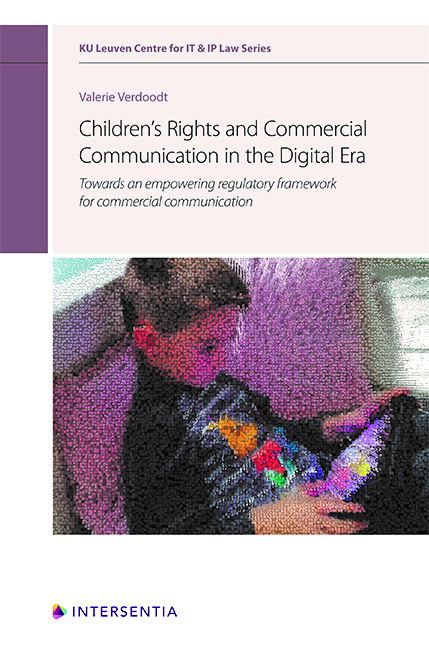 Children's Rights and Commercial Communication in the Digital Era
Children's Rights and Commercial Communication in the Digital Era Book contents
- Frontmatter
- Preface
- Contents
- Abbreviations
- Introduction
- PART I CHILDREN'S RIGHTS AND ADVERTISING LITERACY IN THE DIGITAL ERA
- PART II ASSESSMENT OF THE REGULATORY FRAMEWORK FOR COMMERCIAL COMMUNICATION IN LIGHT OF CHILDREN'S RIGHTS
- PART III ASSESSMENT OF NATIONAL ARIS IN THE AREA OF COMMERCIAL COMMUNICATION
- CONCLUDING REMARKS AND RECOMMENDATIONS FOR THE FUTURE
- Bibliography
- Miscellaneous Endmatter
Chapter II - The Role of Children's Rights in Regulating New Forms of Commercial Communication
Published online by Cambridge University Press: 23 July 2020
- Frontmatter
- Preface
- Contents
- Abbreviations
- Introduction
- PART I CHILDREN'S RIGHTS AND ADVERTISING LITERACY IN THE DIGITAL ERA
- PART II ASSESSMENT OF THE REGULATORY FRAMEWORK FOR COMMERCIAL COMMUNICATION IN LIGHT OF CHILDREN'S RIGHTS
- PART III ASSESSMENT OF NATIONAL ARIS IN THE AREA OF COMMERCIAL COMMUNICATION
- CONCLUDING REMARKS AND RECOMMENDATIONS FOR THE FUTURE
- Bibliography
- Miscellaneous Endmatter
Summary
INTRODUCTION. The aim of this chapter is to gain a deeper understanding of the role of children's rights in regulating new forms of commercial communication. The chapter starts by providing a brief introduction to children's fundamental rights at the international and EU level. It then identifies which children’s rights are at stake, studies how they have been reconfigured in the context of commercial communication and interprets them in this specific context. This interpretation forms the analytical framework for the evaluation of the legislative and alternative regulatory instruments in the following parts of the book.
SECTION I. INTRODUCING THE CHILDREN'S RIGHTS FRAMEWORK
Introduction. Before studying the relevant children's rights and principles, it is important to take a step back and look at how children's rights have emerged, at both the international and European level. This section also introduces children's rights in a digital environment, considering the increased digitisation of children's worlds.
CHILDREN'S RIGHTS AT INTERNATIONAL LEVEL
From subject of protection to active rightsholders From subject of protection… The idea that children are active holders of rights and, as such, form a separate social and legal category is only a recent creation. Until the end of the Middle Ages, the dominant attitude towards children in the Western countries was one of indifference. It was only during the 16th to 18th century that the idea of children as a separate group with specific characteristics and expected behaviour gained prominence. Back then, children were regarded as innocent creatures in need of education, as compared to the “worldly-wise” adults. Alongside this societal attitude towards children, vulnerability and incapacity have also been the bedrock of the Western legal conception of children. At the beginning of the 20th century, the first child protection laws emerged and compulsory education was introduced in most countries. In 1924, the League of Nations adopted the Declaration on the Rights of the Child, which marked the starting point of a journey towards full recognition of children's rights in international law.
…TO ACTIVE RIGHTSHOLDERS. Nowadays, it is generally recognised that the human rights framework is not only applicable to adults but also to children as a specified group. In fact, the United Nations Convention on the Rights of the Child is the most widely accepted instrument of international law, with 193 countries having ratified it (including all EU Member States).
- Type
- Chapter
- Information
- Children's Rights and Commercial Communication in the Digital EraTowards an Empowering Regulatory Framework for Commercial Communication, pp. 55 - 100Publisher: IntersentiaPrint publication year: 2020


